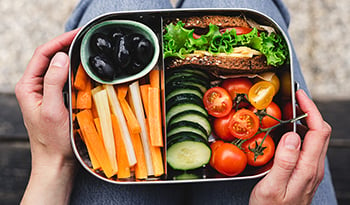How to Achieve Blood Sugar Balance: Best Foods and Lifestyle Tips
DISCLAIMER:This blog does not intend to provide diagnosis...
- In this article:
- What Are Blood Sugars?
- What Causes High Blood Sugar Levels
- What Is Type 1 Diabetes?
- What Is Type 2 Diabetes?
- What Is Gestational Diabetes?
- Diabetes Risk Factors
- Why Do Blood Sugar Levels Matter?
- What Are Optimal Blood Sugar Levels?
- What is A1C?
- What Is Hyperglycemia?
- What Is Hypoglycemia?
- How to Lower Your Blood Sugar Naturally
- 10 Foods for Better Blood Sugar Balance
- Healthy Lifestyle for Better Blood Sugar Management

What Are Blood Sugars?
Blood sugar, also known as blood glucose, is the main sugar found within blood. When you consume and digest food, your body breaks down the food into glucose, which is released into the bloodstream. Insulin, an important hormone produced by the pancreas, is crucial in helping move glucose into cells. Diabetes occurs when blood glucose levels are too high. Over time, high blood sugar levels can contribute to various health issues such as type 2 diabetes, heart disease, nerve damage, eye problems, and kidney disease.
Approximately 37.3 million people of all ages living in the United States (11.3% of the population) had diabetes in 2019.1
What Causes High Blood Sugar Levels
High blood sugar levels can be triggered by a number of factors, including:
- Stress
- Illness
- Overeating
- Snacking between meals
- Diet high in processed foods or sugars
- Lack of exercise
- Insufficient quality or quantity of sleep
- Dehydration
- Certain medications
What Is Type 1 Diabetes?
Type 1 diabetes is an autoimmune condition that typically develops during childhood. With type 1 diabetes, the body attacks and destroys pancreas cells. The pancreas produces insulin, the hormone that helps transport glucose from the blood into the body’s cells. Eventually, the pancreas cannot produce insulin, so glucose stays in the bloodstream, and blood sugar levels rise. People with type 1 diabetes need daily insulin shots or an insulin pump to help transport blood glucose into cells and keep blood sugar within normal levels.
What Is Type 2 Diabetes?
Type 2 diabetes is sometimes called “adult-onset” diabetes because it is often diagnosed in adulthood. Obesity, lack of exercise, chronic stress, and unhealthy eating habits can all increase the risk of developing type 2 diabetes.
What Is Gestational Diabetes?
Gestational diabetes is a type of diabetes that occurs during pregnancy. During pregnancy, the body naturally gains weight and produces more hormones, which can result in changes to hormonal health overall. The body’s cells may use insulin less efficiently, resulting in insulin resistance and an increased risk of gestational diabetes. While insulin and blood sugar levels may return to normal after pregnancy, 50% of women with gestational diabetes develop type 2 diabetes.
Having gestational diabetes can increase the risk of miscarriage, pre-term birth, birth weight over 9 pounds, and a baby with low blood sugar levels. If you are diagnosed with gestational diabetes, it’s important to work with a registered dietitian, nutritionist, and certified diabetes educator who can guide you on managing and maintaining healthy blood sugar levels throughout pregnancy and postpartum.
Diabetes Risk Factors
While you can prevent or delay developing type 2 diabetes with healthy lifestyle choices, you cannot control other risk factors influencing your likelihood of developing type 1 and type 2 diabetes. Family history, genetics, and ethnicity all affect your risk of developing both type 1 and type 2 diabetes.
Why Do Blood Sugar Levels Matter?
Maintaining blood sugar levels within a healthy range can reduce your risk of diabetes and heart disease. Chronic high blood sugar levels can increase the risk of damage to the eyes, nerves, kidneys, and blood vessels.
What Are Optimal Blood Sugar Levels?
Optimal fasting or postprandial (following a meal) blood sugar levels should fall within the following ranges:
People Without Diabetes
- Fasting blood sugar: Less than 100 milligrams per deciliter (mg/dl)
- One hour after meals: Less than 140 mg/dl
- Two hours after meals: Less than 120 mg/dl
Pregnancy
- Fasting blood sugar: Less than 95 mg/dl
- One hour after meals: Less than 140 mg/dl
Adults With Type 1 Diabetes
- Fasting blood sugar: 80 to 130 mg/dl
- One to 2 hours after meals: Less than 180 mg/dl
Adults With Type 2 Diabetes
- Fasting blood sugar: 80 to130 mg/dl
- One to 2 hours after meals: Less than 180 mg/dl
What is A1C?
Hemoglobin A1C, or HbA1c, is a blood test that measures average blood glucose levels over the past three months. The A1C test is often used to diagnose both prediabetes and diabetes and is used to help monitor and manage diabetes over time.2 Elevated A1C is linked to an increased risk of diabetes complications, so it’s important to control A1C levels by maintaining healthy blood sugar levels over time.
What Is Hyperglycemia?
Hyperglycemia, also known as high blood sugar or high blood glucose, occurs when the level of sugar in the blood is elevated. Symptoms of hyperglycemia include:
- Thirst
- Fatigue
- Feeling weak
- Headaches
- Frequent urination
- Blurred vision
What Is Hypoglycemia?
Hypoglycemia, also known as low blood sugar or low blood glucose, occurs when the level of sugar in the blood is too low. Symptoms of hypoglycemia include:
- Sweating
- Hunger
- Feeling weak
- Difficulty making decisions
- Irritability
- Confusion
- Dizziness
How to Lower Your Blood Sugar Naturally
Many dietary and lifestyle habits can help lower blood sugar levels naturally! Incorporate these healthy habits to lower or maintain blood sugar levels.
- Movement. Aim for 30 minutes of continuous movement daily to support healthy blood sugar levels. Taking a walk after a meal or snack can also help the body use up glucose to help reduce blood glucose levels.
- Eat protein first: Some research suggests that eating the protein and fiber-rich foods within your meal or snack first, followed by the carbohydrate foods, can result in a lower blood sugar spike.3 Aim to include a source of protein in all meals and snacks.
- Eat a high-fiber diet: Fiber-rich foods not only support bowel regularity and gut health—they also help reduce blood glucose spikes. Emphasize whole, plant-based foods to ensure you are consuming adequate fiber.
- Stay hydrated: Dehydration can adversely affect blood sugar levels. Stay hydrated with filtered water, herbal teas, and water-dense foods like cucumbers, lettuce, and citrus fruits.
- Eat whole foods: Whole foods like fruits, vegetables, nuts, seeds, legumes, and whole grains contain fiber, which slows digestion and lessens the spike of blood glucose levels.
- Avoid processed foods: Limit or avoid processed foods high in refined flours and added sugars, which can spike blood sugar levels.
- Reduce stress: Implement daily habits that can help lower your stress levels, such as meditation, reading, listening to calming music, going on a walk, spending time in nature, talking with a friend, taking a bath, meditating, journaling, or taking a nap! When you are chronically stressed, your body produces cortisol and adrenaline to help you flee the perceived threat you are experiencing. Insulin levels may also increase to release sugar into the blood for added fuel your body thinks it needs to escape the danger. However, most stressful situations today do not require running away from danger. Instead, we may be stressed sitting at our computers, commuting, or looking at our phones. By incorporating healthy, stress-reducing habits, you can better support your insulin and blood sugar levels.
- Sleep: Adequate sleep is essential for overall health and healthy blood sugar levels. Abundant research shows that poor quality sleep, insufficient or excessive sleep, and irregular sleep all promote glucose intolerance.4
10 Foods for Better Blood Sugar Balance
- Apple cider vinegar: Consuming 4 teaspoons of apple cider vinegar, diluted in water, before a meal has been shown to reduce postprandial (post-meal) blood sugar levels.5 This may help support both blood sugar levels and insulin health.
- Almonds: Almonds contain fiber, zinc, magnesium, and monounsaturated fats, which help promote satiety and glycemic control.
- Dark chocolate: Dark chocolate contains magnesium. Magnesium plays an important role in muscle relaxation and may support better sleep and help reduce feelings of stress, all of which are important for better blood sugar management.6 A magnesium supplement can also help you meet your magnesium needs.
- Cinnamon: Research shows that adding cinnamon to a meal or snack can help lower blood sugar levels.7
- Hemp seeds: One 2-tablespoon serving of hemp seeds provides 10 grams of plant-based protein along with fiber and omega-3 fats. Hemp seeds, also called hemp hearts, are excellent seeds for supporting blood sugar levels.
- Prunes: Prunes are great on their own as a snack or as a natural way to sweeten a meal, snack, or baked recipe. Prunes are a low-glycemic fruit and contain soluble fiber, which can help moderate blood sugar levels.
- Nut butter: Nuts are rich in fat, protein, and fiber, all of which take longer to digest than carbohydrates and help support healthy blood sugar levels.
- Lentils: Lentils are a high-protein, high-fiber legume. Abundant research suggests consuming legumes can help lower the risk of diabetes.8
- Oats: Oats contain soluble and insoluble fiber, which support microbial diversity in the body and bowel regularity. Oats have even been shown to help significantly reduce A1C levels.9
- Pumpkin Seeds: Pumpkin seeds are great for blood sugar control. They are packed with protein, fiber, healthy fats, and zinc. Consuming adequate zinc is associated with healthy insulin production and blood sugar control.10
Healthy Lifestyle for Better Blood Sugar Management
Incorporating healthy lifestyle habits like balanced nutrition, regular movement, stress management, and high-quality sleep can all support healthy blood sugar levels. If you are concerned about your blood sugar levels, consult your doctor or registered dietitian to discuss your health and nutrition.
References:
- Diabetes Statistics | NIH. Accessed 7/17/23.
- All About Your A1C | CDC. Accessed 7/17/23.
- Kubota S, Liu Y, Iizuka K, Kuwata H, Seino Y, Yabe D. A Review of Recent Findings on Meal Sequence: An Attractive Dietary Approach to Prevention and Management of Type 2 Diabetes. Nutrients. 2020 Aug 19;12(9):2502.
- The Impact of Poor Sleep on Type 2 Diabetes | NIH. Accessed 7/17/23.
- Gheflati A, Bashiri R, Ghadiri-Anari A, Reza JZ, Kord MT, Nadjarzadeh A. The effect of apple vinegar consumption on glycemic indices, blood pressure, oxidative stress, and homocysteine in patients with type 2 diabetes and dyslipidemia: A randomized controlled clinical trial. Clin Nutr ESPEN. 2019;33:132-138.
- Arab A, Rafie N, Amani R, Shirani F. The Role of Magnesium in Sleep Health: a Systematic Review of Available Literature. Biol Trace Elem Res. 2023;201(1):121-128.
- Hasanzade F, Toliat M, Emami SA, Emamimoghaadam Z. The Effect of Cinnamon on Glucose of Type II Diabetes Patients. J Tradit Complement Med. 2013 Jul;3(3):171-4.
- Bielefeld D, Grafenauer S, Rangan A. The Effects of Legume Consumption on Markers of Glycaemic Control in Individuals with and without Diabetes Mellitus: A Systematic Literature Review of Randomised Controlled Trials. Nutrients. 2020 Jul 17;12(7):2123.
- Hou Q, Li Y, Li L, Cheng G, Sun X, Li S, Tian H. The Metabolic Effects of Oats Intake in Patients with Type 2 Diabetes: A Systematic Review and Meta-Analysis. Nutrients. 2015 Dec 10;7(12):10369-87.
- Cruz KJC, de Oliveira ARS, Morais JBS, et al. Zinc and Insulin Resistance: Biochemical and Molecular Aspects. Biol Trace Elem Res. 2018;186(2):407-412.

 By Megan Roosevelt, RDN
By Megan Roosevelt, RDN


